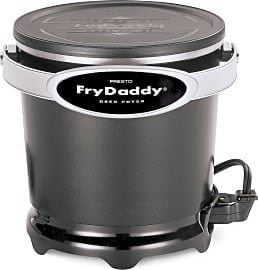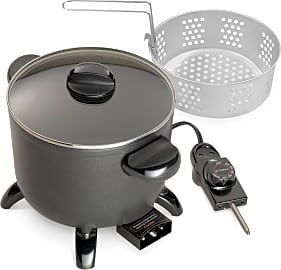The 9 Best Deep Fryers

This wiki has been updated 41 times since it was first published in May of 2015. Deep-fried food is juicy and delicious, if not, perhaps, the most healthy choice. Because deep frying is such a popular style of cooking, there are many fryers on the market that let you make your own breaded shrimp, donuts, chicken, french fries, and more, as fresh and hot as can be, and all without paying a ton. Just be careful around hot oil and especially open flames. When users buy our independently chosen editorial selections, we may earn commissions to help fund the Wiki.
Editor's Notes
July 30, 2021:
We've said it before but it bears repeating; be extremely careful when working with hot oil and don't drop in anything that's still frozen. We can't stress enough how important it is to thaw most foods out to avoid oil explosions, especially in models designed for home use. With that out of the way, there were no big changes while updating the list today. Most homeowners will appreciate the T-fal FR8000 the most due to its ease of cleaning, although we're still excited by the Cuisinart CDF Series. The top model sports a novel rotisserie deep-fry technique that greatly reduces fat intake while still resulting in crispy skin on whole poultry.
April 17, 2020:
We'd be remiss to not mention the potential dangers of deep frying; you're probably aware that hot oil is dangerous, but it's especially important to use caution when deep frying outside using a propane-powered fryer. For example, when using the high-capacity Bayou Classic 700-701 or R&V Works Cajun, and especially when working with any kind of traditional turkey fryer, it's imperative to take along a fire extinguisher and make absolutely certain that you're cooking on flat and stable ground.
Naturally, you won't have the same issues with smaller fryers such as the T-fal FR8000; in fact, you should have very few issues with this one thanks to its automatic oil filtration system, which cuts down on residue and preserves the life of your oil, which saves time, money, and hassle. The Cuisinart CDF Series is another interesting one, in particular its top-of-the-line model, which uses a rotisserie function to ensure even cooking while reducing calories as compared to traditional deep frying. At 10 liters, the Masterbuilt Butterball XL is about as big as they come without moving to a commercial-style model, which most people simply won't be able to fit or install in their home. The Secura Triple-Basket is similar to all three of those but slightly less technically advanced and also less expensive.
If you're okay with somewhat smaller capacities, there are a few choices that may prove even more convenient. The Presto FryDaddy is small and the Presto GranPappy medium-sized, and neither one of them requires you to do anything but plug it in and wait a few minutes for it to heat up. Alternately, the Presto Kitchen Kettle does have a temperature knob, and it goes low enough to work as a slow cooker for a decent variety of dishes aside from just fried food, though you'll want to make sure you keep it extra clean if you're going to make stews or soups. And if you're looking for something much more traditional, take a look at the Tramontina Professional, which sits on a stove and requires you to monitor its temperature closely, but is assembled in the USA of quality materials and should last for a very long time.
Special Honors
R&V Works Cajun Fryer Not everyone needs this kind of capacity, but if you're among those high-volume cooks, it's hard to beat this varied and versatile line of outdoor deep fryers. It comes as large as 17 gallons, but we particularly like the Cajun Jimmy, which can fry 3 turkeys at once or feed up to 100 people per hour on fish, french fries, and hush puppies. cajunfryer.com
Avantco Equipment If you're outfitting a new restaurant, Avantco's floor fryers are definitely worthy of your consideration, as they're not the most expensive commercial options but they do offer plenty of quality and reliability. They're offered in both propane and natural gas configurations to suit your specific needs. avancoequipment.com
Nothing Beats The Browning
That could spell disaster for certain foods, like meats, unless you have a way to protect them.
If you've ever wondered why foods brown as you cook them, why breads and pretzels develop that perfect brown, crusty exterior, or why french fries deepen in color on the outside, you simply have to consult French chemist Louis Camille Maillard. Unfortunately, Mr. Maillard died in 1936, so communing with him is a little tough, but his discovery was so monumental in the world of food chemistry that they went ahead and named it after him.
The Maillard reaction occurs when a substance containing both sugars and proteins reaches a certain temperature, usually between 284 and 329 degrees Fahrenheit. At temperatures above this, the reaction happens alongside caramelization, a process by which browning sugars unleash an organic chemical called diacetyl, which boasts an incredibly nutty, buttery flavor.
When you deep fry any food, the desired oil temperature usually falls somewhere between 350 and 375 degrees Fahrenheit, hot enough to induce both the typical Maillard reaction and a healthy turn of caramelization. The hot oil also provides an additional reaction, which is the rapid dehydration of the food being fried.
A piece of food submerged in hot oil will cook quickly and from all sides, its moisture rapidly withdrawing into the oil and evaporating from the intense heat. That could spell disaster for certain foods, like meats, unless you have a way to protect them. This is where breading comes in.
If you took a piece of chicken and dropped it bare in a deep fryer, it would emerge cooked, but awfully dry. Take that same piece of chicken, cook it slowly and properly outside the fryer to preserve its juices, then bread it and fry it, and it will emerge cooked to juicy perfection and encased in a delicious, breaded crust.
The reason for this is that the breading browns, caramelizes, and dehydrates so quickly that it forms a kind of protective shell around the food, allowing the cooked chicken inside to reheat (breading won't stick as well to hot meats; best to let them cool before frying), while maintaining all its juiciness and flavor.
Get Fit With Fat
Since deep frying requires a vat of oil that doesn't dip anywhere below 350 degrees Fahrenheit for more than a few seconds, it's imperative that you have a deep fryer capable of maintaining high temperatures, even as you add cold food to the vat. Most of the deep fryers on our list are electric, increasing the temperature of their oil through the use of powerful heating elements, not unlike those of an electric stove.
There are also models that hook up to a propane line so that you can use actual fire underneath your fryer.
There are also models that hook up to a propane line so that you can use actual fire underneath your fryer. The advantage of these is cost, as it requires a tremendous amount of electricity to heat the oil and keep it hot, where a steady flame from a propane tank is only as expensive as the gas refills.
Whichever style of fryer you eventually take home, it's important to remember that fat can be your friend in the 21st century. A variety of low-carb diets popularized throughout the 1980s and 1990s came close to this truth, but fear of fat was still too great for them to break into the best part of it.
It turns out that you can actually utilize your deep fryer to lose weight and regulate your body's systems by going on what's called a ketogenic diet. Ketogenic dieting is based around a state of ketosis, when your body elects to burn fat the way that it normally burns carbs. It takes a few days and a very specific balance of very few carbs, a healthy amount of protein, and an amazing amount of fat to get your body to switch over, but most of the people who do so immediately start to see a burn.
Of course, you can't go deep frying Oreos and donuts if you want the plan to work, but at least you don't have to deny yourself the tastiest food group.
Deep Fried History
While an unhealthy habit of consuming the worst kinds of deep fried foods might be a relatively recent phenomenon, the act of deep frying reaches far back to the days in which we all assume everybody was fit and healthy. We're talking about going way back to the fifth millennium BCE in Egypt, where we find archaeological evidence of deep frying.
They've given the world donuts, onion rings, corn dogs, deep fried Twinkies and Oreos, and just about every other thing you wouldn't expect a person to deep fry.
The Greeks and Italians were the next civilizations to document any kind of deep frying, and the method quickly spread across Europe and the Middle East, regions that created the funnel cake, the falafel, and the french fry. By the sixteenth century, the practice reached the far east through Japan by way of Portuguese merchants.
While these methods of deep frying were well-documented and enjoyed by the people that ate from them, there was still one major revolution in the craft on the horizon: the American South. Nobody fries food like a southerner. They've given the world donuts, onion rings, corn dogs, deep fried Twinkies and Oreos, and just about every other thing you wouldn't expect a person to deep fry.
Health concerns over the amount of oil in the average American's daily diet are certainly valid, but that has more to do with the foods being fried than with the act of frying itself. If done properly, deep frying can be a healthy, inexpensive addition to a happy kitchen.














